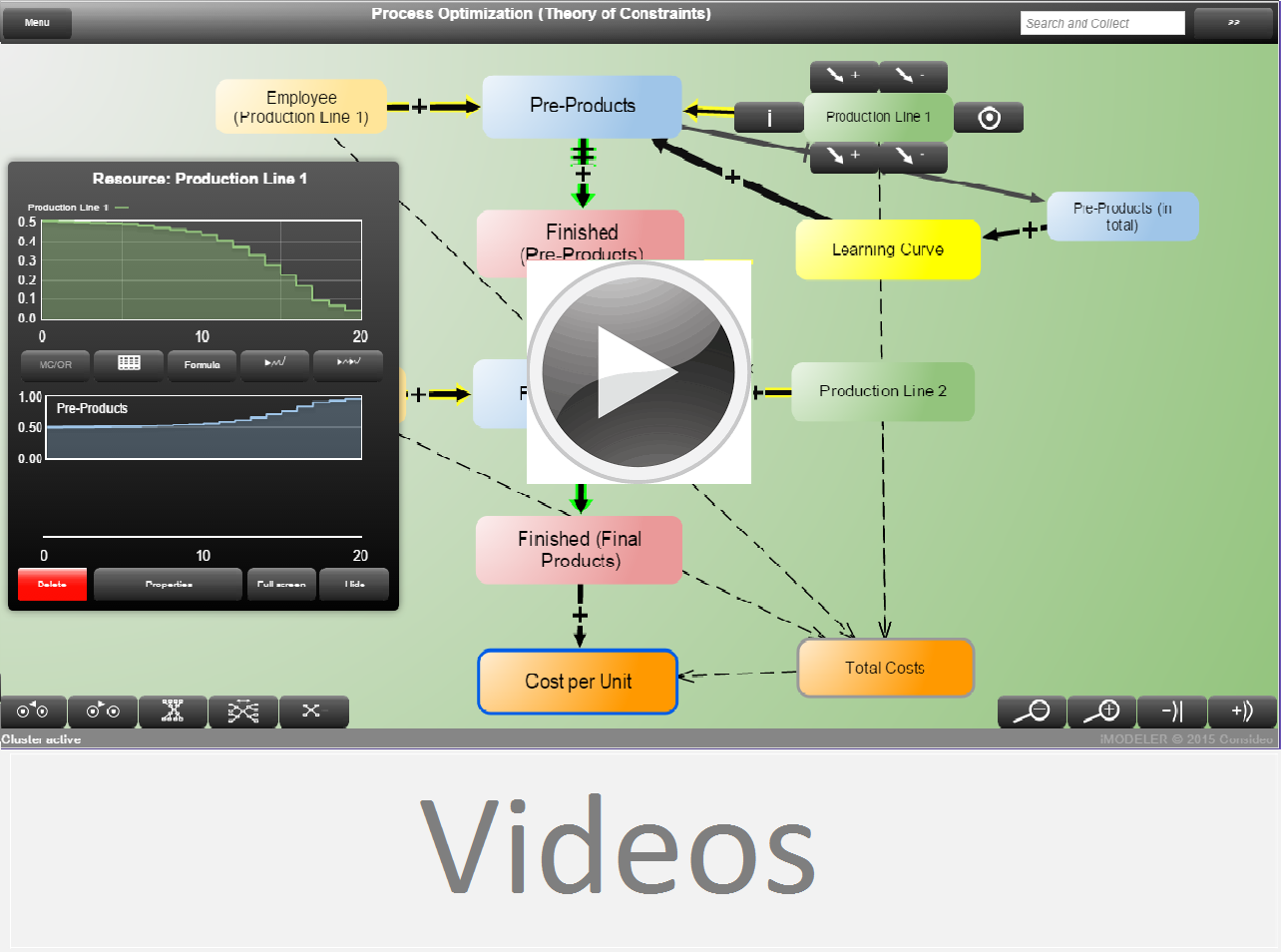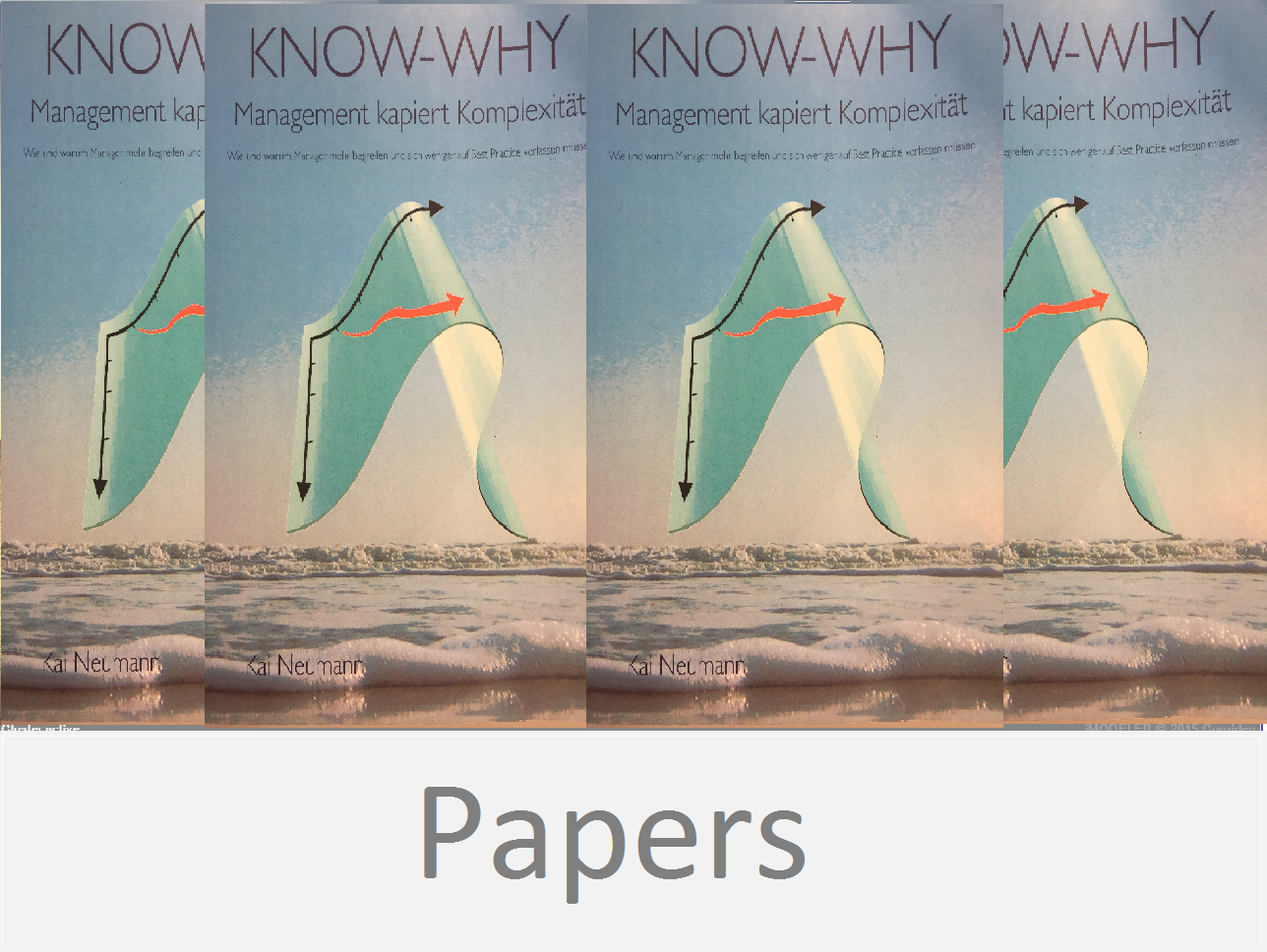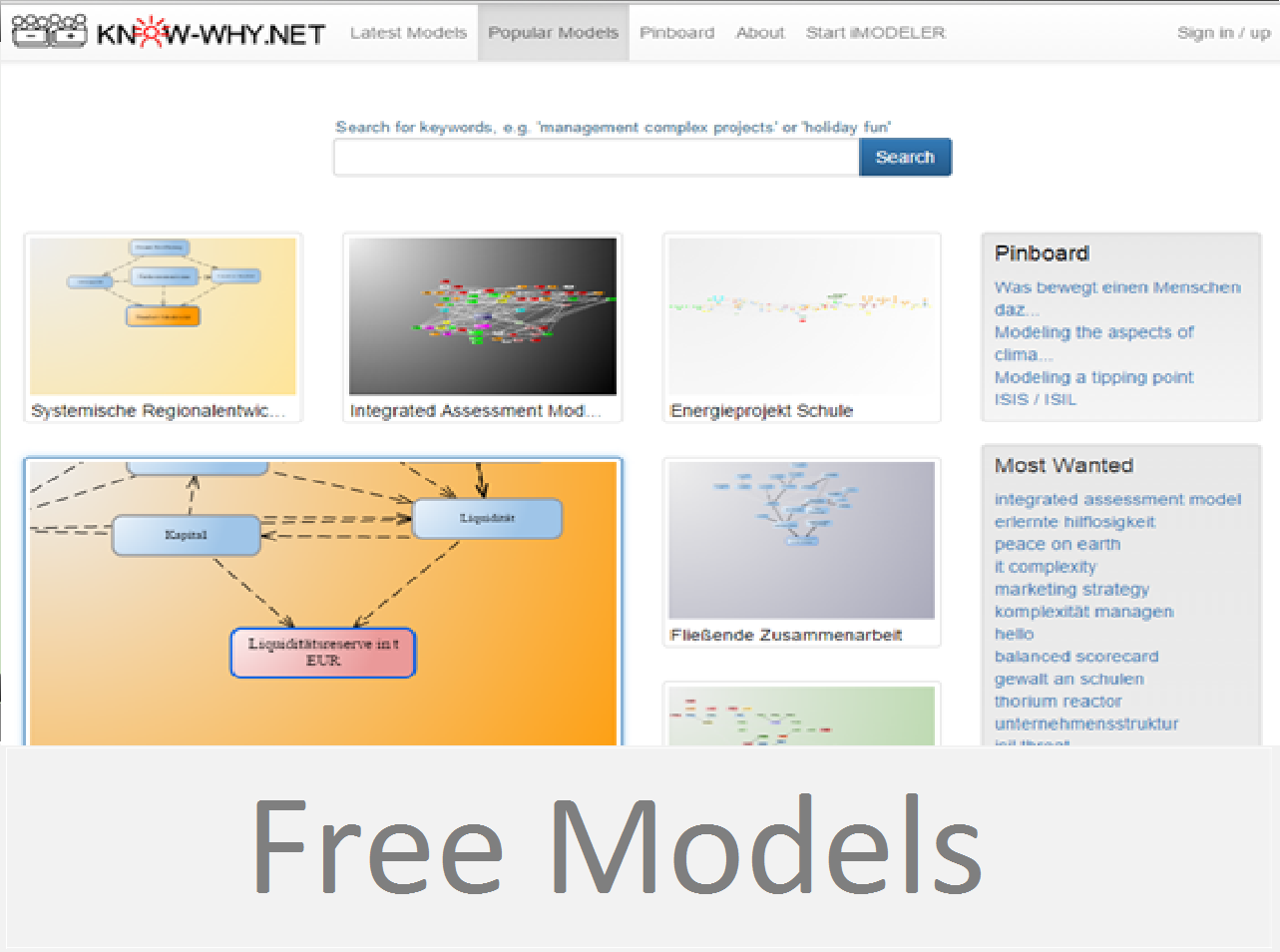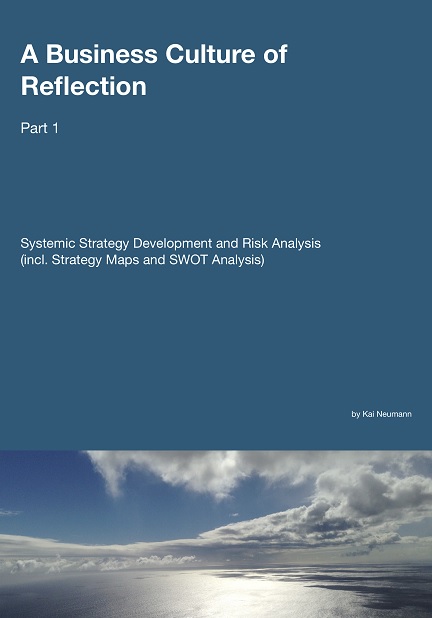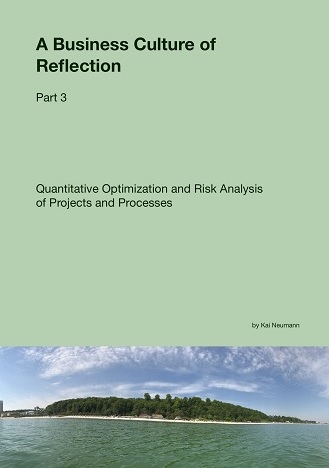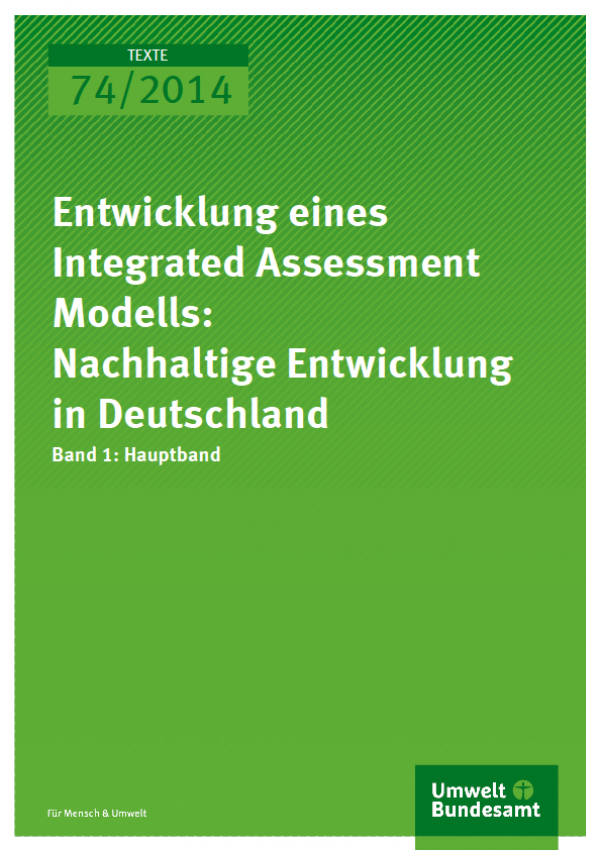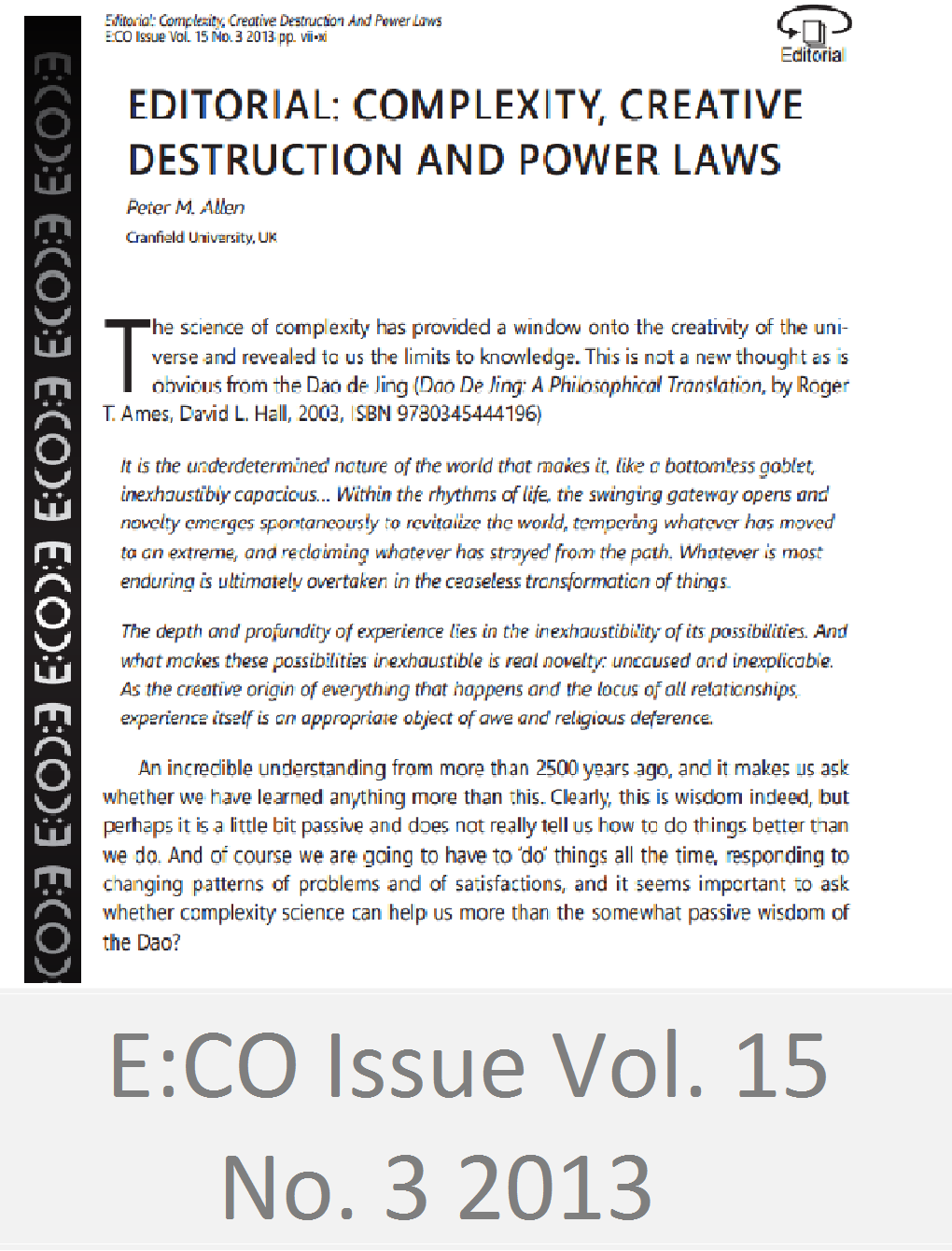Papers
Consideo White Papers, Articles etc.
iM-AI .... iMODELER features ChatGPT etc.
Luebeck, May 2025
With iM-AI Consideo has introduced six AI functions to iMODELER
Artificial Intelligence (AI) is used in all fields, also for systems thinking and modeling. Consideo is actually working on it for more than a decade and we are still not satisfied. However, the current developments of LLMs like ChatGPT inspire us to offer some features to support your quest to identify the crucial factors to your challenges.
Currently (05-2025) we are developing six functions to support your modeling using the iMODELER:
1. Providing a GPT/Agent*/… that uses the KNOW-WHY-Method to develop explorative models on any topic. The result can be imported into iMODELER with descriptions, categories and weights. You can use your account from ChatGPT or You.com….
2. Integrating ChatGPT to come up with influencing factors directly within iMODELER (no account from ChatGPT needed)
3. Providing a GPT/Agent*/…. to derive a cause and effect model from a document uploaded to ChatGPT/ you.com/… You can use your account from ChatGPT or You.com….
4. Providing a GPT/Agent*/… to get a text description of a model you upload to your ChatGPT, You.com…. accounts
5. Providing a GPT/Agent*/… to get a causal loop diagram (CLD) to be imported to iMODELER using your ChatGPT, You.com…. accounts
6. Providing a GPT/Agent*/… to get a model you upload to your ChatGPT, You.com…. accounts improved
*you.com still doesn’t allow for feasible file downloads so the agents will be provided at a later time.
You can download a quick guide here.
Systemic Stakeholder Analysis
Systemic Stakeholder Analysis - Background on the methodology and its application within the Bio-Mo-D project
Autoren: Kai Neumann, Marguerite Sievi
Abstract: A multitude of stakeholders, encompassing various sectors, are involved in the modernization of ecosystem-related reporting in Germany at both corporate and national levels. The Bio-Mo-D project aims to identify pathways towards these objectives and recognize key stakeholders and their roles. Employing an explorative stakeholder model aids in comprehending the factors facilitating and hindering each objective, as well as the interconnections between them and the roles played by numerous stakeholders. A refined descriptive model further illustrates generic dynamics, facilitating the identification of major stakeholders along impact chains. This enhanced understanding of processes, triggers, and dynamics enables the Bio-Mo-D project to identify e.g. potential advocacy coalitions, underscoring the significance of pilot applications in catalyzing the dynamics of reinforcing feedback loops in the mainstreaming process and the need for feasible science-policy-interfaces.
You can download the publication here.
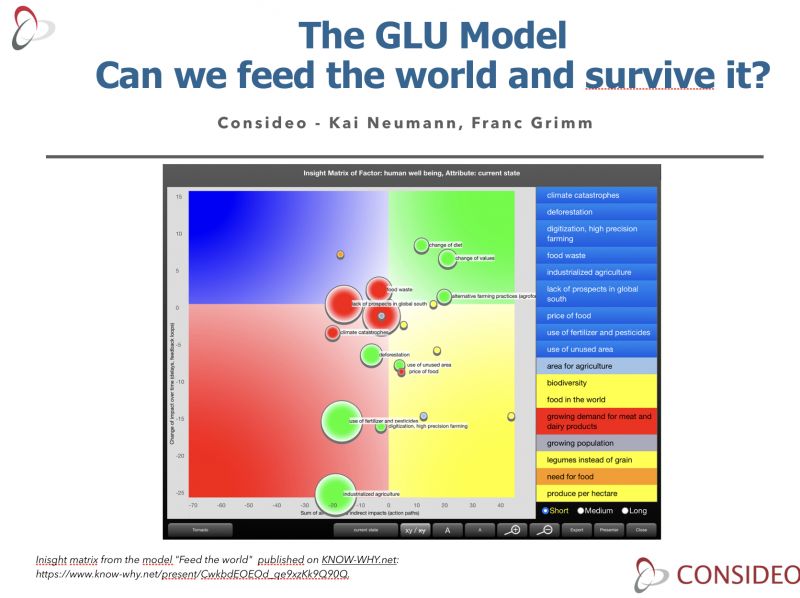 Luebeck, 14.06.2023
Luebeck, 14.06.2023
Grey series - part 10: The GLU Model - Can we feed the world and survive it?
Authors: Kai Neumann and Franc Grimm
Abstract:
A simulation model to explore our chances to feed the world without continued deforestation.
Here you can read the paper:
 Luebeck, 08.11.2022
Luebeck, 08.11.2022
Grey series - part 9: Why iMODELER - a guide to its unique features
Authors: Kai Neumann and Franc Grimm
Abstract:
The iMODELER is probably the leading software to visualise and analyse interconnections. We can collect arguments around our challenges and directly translate them into cause and effect relations.
Here you can read the paper:
Research Article: Journal of Sustainable Development of Energy, Water and Environment Systems (Kopie)
 SDEWES: Year 2022, Volume 10, Issue 4, 1100427
SDEWES: Year 2022, Volume 10, Issue 4, 1100427
Material Efficiency and Global Pathways towards 100% Renewable Energy Systems - System Dynamics Findings on Potentials and Constraints
Authors: Kai Neumann, Carl Anderson, and Martin Hirschnitz-Garbers
Published in Journal of Sustainable Development of Energy, Water and Environment Systems
Abstract: Global climate mitigation requires a renewable energy transition. Due to interactions between energy demand and material use, improvements in material efficiency promise to contribute to climate mitigation. System dynamics modelling was applied to test four different scenarios toward a 100% renewable energy world to analyse such potentials. The model findings show that a 100% renewable energy world with zero greenhouse gas emissions seems feasible, but the chosen pathway matters. Material efficiency reduces emissions and increases the availability of secondary raw materials for renewable energy generation. However, only absolute reductions in energy demand through sufficiency-oriented lifestyles and sustainable choices in food, housing, and mobility seem to achieve the emission reductions needed to stay within 1.5-degree warming. International policies are needed to create equitable opportunities for decent lifestyles in a safe and just planetary space.
View / Download article here
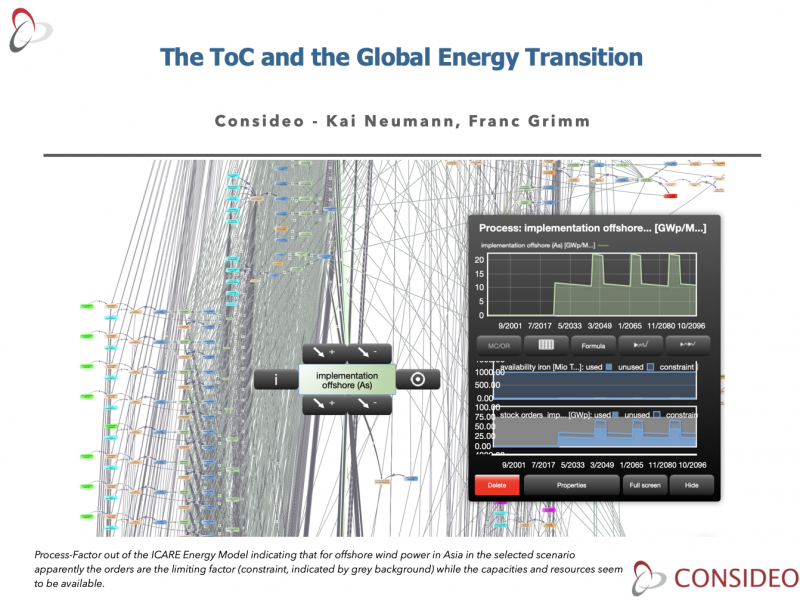 Lübeck, 11.03.2022
Lübeck, 11.03.2022
Grey Series - Part 8: The ToC and the global energy transition
Autoren: Kai Neumann und Franc Grimm
Abstract:
After we had already investigated the global transformation towards renewable energies with the GEE(R) model (Grey Series - Part 1: Renewable Energy - It Could Be Done), we took another look at the global energy transition with the ICARE model for the Federal Environment Agency and explored the role of resources even more.
Together with Ecologic Institute, we first qualitatively investigated the nexus between climate protection and resource conservation, and then quantitatively used simulation models to look not only at the extent to which sufficient raw materials are available for the global expansion of renewable energies, but also at the effects of resource efficiency, an increased choice of photovoltaics, the import of synthetic fuels, or the substitution of greenhouse gas intensive steel and concrete with biotic raw materials.
We will address the substantive aspects of this project first with peer-reviewed publications elsewhere and only later expand on this paper. With the gray paper here, we describe the application of the Theory of Constraints (Goldratt " The Goal") and its further findings. The iMODELER has special factors for modeling process steps and resources and already shows the potential constraints (limiting factors, bottlenecks) at certain points in time.
Other insightful aspects are the dangers of thinking of a critical path instead of a critical chain (Goldratt "Critical Chain") or a "Shifting the burden to the intervenor" archetype (Senge "The Fifth Discipline").
We show that late targets lead to missed targets and that energy imports of solar power or synthetic fuels that seem to make sense nationally lead to potential constraints internationally.
Here you can download the paper.
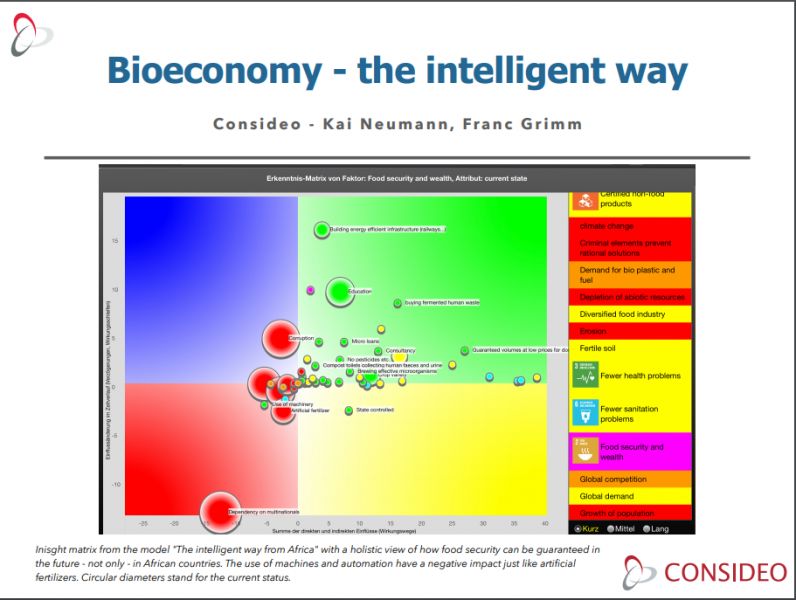 Luebeck, 11.04.2020
Luebeck, 11.04.2020
Grey series - part 7: Bioeconomy - the intelligent way
Authors: Kai Neumann and Franc Grimm
Abstract: As part of an extensive project on food security in sub-Saharan countries (using Ethiopia, Nigeria and Ghana as examples), we have been able to gain numerous systemic insights through qualitative, participatory, explorative stakeholder modelling and a quantitative simulation model on biomass, money and information flows, taking into account socalled megatrends and the UN Sustainable Development Goals.
According to this, classical consulting approaches, which recommend increasing agricultural productivity in African (and other developing) countries through the use of machinery, pesticides (in combination with seeds from multinational corporations) and artificial fertilizers on large fields, are, viewed in a systemic context, an aberration.
Indeed, land productivity should be increased and more land should be used, but the labour intensity in agriculture should be maintained against the background of global automation and digitalisation of other sectors and fatal urbanisation. Cultivation practices should be resilient with legumes, agroforestry, a recirculation also of human biomass, etc. without dependence on multinational corporations and with a minimization of vulnerability to weather extremes (floods and droughts caused by climate change).
Following the primacy of self-sufficiency through state-guaranteed prices, export goods should not be marketed internationally according to price, but according to the criterion of sustainability with appropriate labels.
The "Grey Series": with the "grey series" we offer the public an attractive, readable format that summarizes insights form our research work and the action to be taken. Our 'grey series' based on the term 'grey literature'.
Here you can downlaod the paper directly. Here you will find some additional papers.
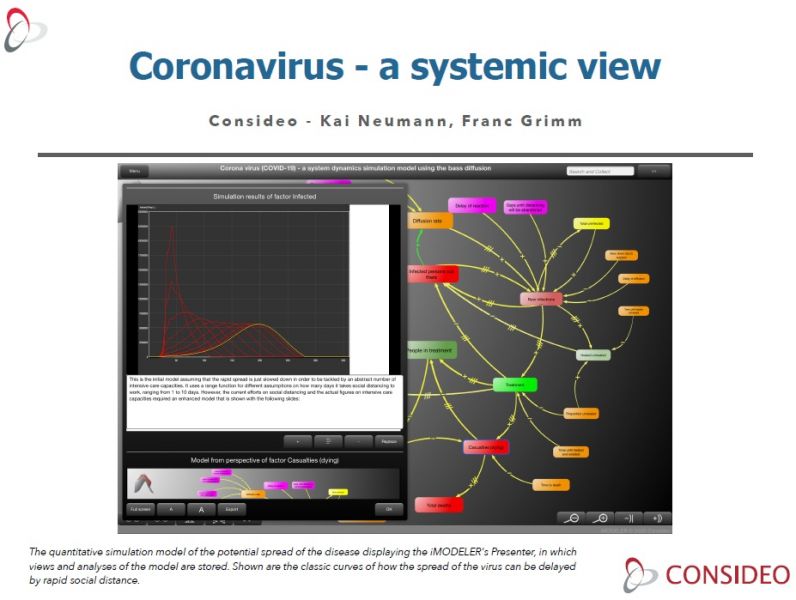 Lübeck, 24.03.2020
Lübeck, 24.03.2020
Grey Series - Part 6: Coronavirus - a systemic view
Autoren: Kai Neumann und Franc Grimm
Abstract: Fortunately, simulation models are currently providing the basis for understanding the potential spread of global corona infections and deaths. Media and politics take up the representations of simulation curves and point out the necessity of flattening the bell curve and shifting the spread forwards on the time axis.
Originally intended only as a tool for use by experts, we have published on KNOW-WHY.net a System Dynamics model to reproduce these curves. With each aspect of this virus we have then extended the model to discover that the event space is, or must be, potentially larger than currently discussed.
Thus, there are scenarios where it takes almost 2 years before the virus disappears at the greatest possible social distance - subject to the prior development of vaccines and cures. In a qualitative model, we have then explored factors that call into question the economic and social viability of maintaining social isolation for such a long time. This model also explores the possibility of isolating and protecting only vulnerable groups of people by all means, and letting the rest of the population survive the disease relatively quickly - a scenario that we would not have agreed to two weeks ago before a more precise simulation of developments.
While the economy could theoretically hold out longer through globally concerted money creation, we do not believe that social chaos will be eliminated. Therefore, there is a certain probability that we will have to shift to the isolation of a few people.
The "Grey Series": with the "grey series" we offer the public an attractive, readable format that summarizes insights form our research work and the action to be taken. Our 'grey series' based on the term 'grey literature'.
While overly complicated models can hardly do justice to the complexity of local, social relationships, many rough models have not yet been adapted to the particularities of the COVID-19 virus. We have now adapted our rough model and hereby present the possible (!) findings from this. In addition, we offer a qualitative cause-and-effect model to reflect further implications.
Here you can download the paper.
 Luebeck, den 30.04.2021
Luebeck, den 30.04.2021
Grey series - Part 5: How and why change is possible?
Authors: Kai Neumann and Franc Grimm
Abstract:
In two projects for the German Environment Agency, Consideo and renowned partners have systemically investigated the potentials of a societal transformation towards more sustainability.
An qualitative Integrated Assessment Model shows the importance of emotional effectiveness of alternative behavior depending on guiding principles and the possibility to measure the benefits of our actions. It is no wonder that we change too slowly, where currently in vicious circles each actor waits for support in the form of appreciation from other actors (lock-in effect). Emotionally effective behavioral changes of the population through appropriate offers from business and politics can turn vicious circles into virtuous circles.
The comprehensive D3 simulation model then shows the potential of exponential change across different social milieus and behavioral domains and the associated consequences for the environment, climate, economy, welfare and happiness. According to the model, such a change would hardly harm the economy while welfare and happiness would increase significantly.
Here you can directly download the publication.
 Luebeck, den 30.04.2021
Luebeck, den 30.04.2021
Grey series - Part 4: ICT - utopia or dystopia?
Authors: Kai Neumann and Franc Grimm
Abstract:
Using a series of qualitative cause-and-effect models, we investigated the possibility of simulating the global spread of information and communication technologies for the Federal Environment Agency. The goal was to estimate the associated resource use and energy demand.
The great challenge is actually to predict the spread, since potentially disruptive developments are possible with the technologies, and since the assumption that there will simply be further growth of the economy and material wealth globally through optimized processes falls short.
Thus, in the simplest case, ICT may indeed simply accompany people's everyday lives and people at work. However, it is equally possible that automation and digitization will extremely increase productivity and save jobs, which can then also lead to a two-class society with correspondingly different ICT, depending on social policy. It is also conceivable that ICT will become more than just an accompaniment to our lives, and technologies will omnipresently change how we eat, how we move, what decisions we make in life and much more.
And finally, there is the possibility that technologies will take on a life of their own and artificial intelligence will set itself exponentially evolving goals that will make us humans more or less superfluous. This sounds gloomy, but it can be logically deduced and is now also being held out as a prospect by other prominent parties.
The "gray series": With the "gray series" we offer the public a format that is attractive to read, which brings findings from our research projects and actions to be derived from them to the point - our 'gray series' in reference to the term "gray literature".
Information and communication technologies, and with them digitization, automation and artificial intelligence, are discussed with a lot of hope and naivety in terms of sustainability. Hope that processes will be optimized. Naivety that development could be normatively controlled. Thus, optimized processes quickly mean rebound effects with simply more material consumption. The spread of ICT follows economic, technological and social developments and their socio-economic and psychological drivers in a self-dynamic way.
This paper highlights these inherent dynamics and puts the current discussion about policy options into perspective.
Here you can directly download the publication.
A Business Culture of Reflection - Part 5: Systemic Management and Organizational Development featuring the KNOW-WHY Method
Autor: Kai Neumann
Abstract: After the four previous papers of this series emphasized different practical applications of systems thinking and modeling in order to reflect on the complex challenges of an enterprise or a project, this paper now tackles the question of how to establish a culture of reflection within an organization that is eager and able to perform and maintain systems thinking. The paper explains what this means, what the major obstacles are, how to initiate the change and how to maintain a culture beyond our current dominant structure of a single person’s sovereignty of interpretation.
This guidance comes in a series of guidances for “A Business Culture of Reflection” in line with:
1. Systemic Strategy Development including Risk and SWOT analysis
2. Systemic Product Development featuring Idealized System Design
3. Quantitative Optimization and Risk Analysis of Projects and Processes
4. Systemic Project Management
5. Systemic Management and Organizational Development featuring KNOW-WHY Method
The series describes the application of the software iMODELER (both, the freeware and the full version) for the example of a start-up enterprise (newly founded or a profit center within a company) that plans to become successful with developing, manufacturing and selling a revolutionary electric car.
The 'business culture of reflection' captures the idea that any enterprise can leverage the collective potential of its employees by collaboratively looking at the interconnections of all the existing arguments within the enterprise (and also from the stakeholders outside). Not only the all-too-common phenomenon of endless and repeated meetings with little progress but also that of reluctant or simply unfounded decision-making can be tackled with this change of corporate culture.
Here you can download the guidance: A Business Culture of Reflection – Part 5
 Luebeck, den 30.04.2021
Luebeck, den 30.04.2021
Grey series - Part 3: Battery Electric Vehicles - no H2!
Authors: Kai Neumann and Franc Grimm
Abstract:
In a simulation model for the German Federal Environment Agency, Consideo has answered the question of whether enough lithium would be available for battery-electric mobility (BEM) of not only cars, but also trucks, buses, short-range aircraft and ships. Scenarios allow to vary the number of vehicles, the technology of the batteries (size, efficiency), the needs of other applications and also the deposits of lithium.
The baseline scenario examines today's technology and common predictions of global vehicle population (passenger cars from 1billion today to 1.5billion in 2060). According to this, lithium supplies would run out in 50 years. However, this also means that with smaller batteries, with foreseeable double efficiency, with high recycling, and with smaller vehicle inventories that also make sense for other reasons, lithium stocks do not appear to be depleting.
In the context of global renewable energy expansion (see paper on the GEE(R) model), these results mean that the high efficiency of e-drives and batteries is preferable to the comparatively much lower efficiency of hydrogen and synthetic fuels (e-fuels), especially since these are needed for reverse power generation during dark periods and for ocean shipping and long-distance flights.
A successful BEM must start in time and build high lithium mining capacities closely followed by recycling capacities.
The "gray series": With the "gray series" we offer the public an attractive format to read, which brings findings from our research projects and actions to be derived from them to the point - our 'gray series' in reference to the term "gray literature".
"Battery Electric Mobility - No H2" is an important contribution to the current debate on e-mobility. Although the number of cars in the world should be significantly reduced, lithium is not a reason not to switch to efficient, battery-electric mobility. Inefficient hybrid technology, hydrogen powertrains or even synthetic fuels do not make sense wherever batteries can be used (including trucks, airplanes, ships).
The GEE(R) model adds that much of the electricity can be provided from renewable sources, and hydrogen is needed elsewhere.
You can download the publication directly here.
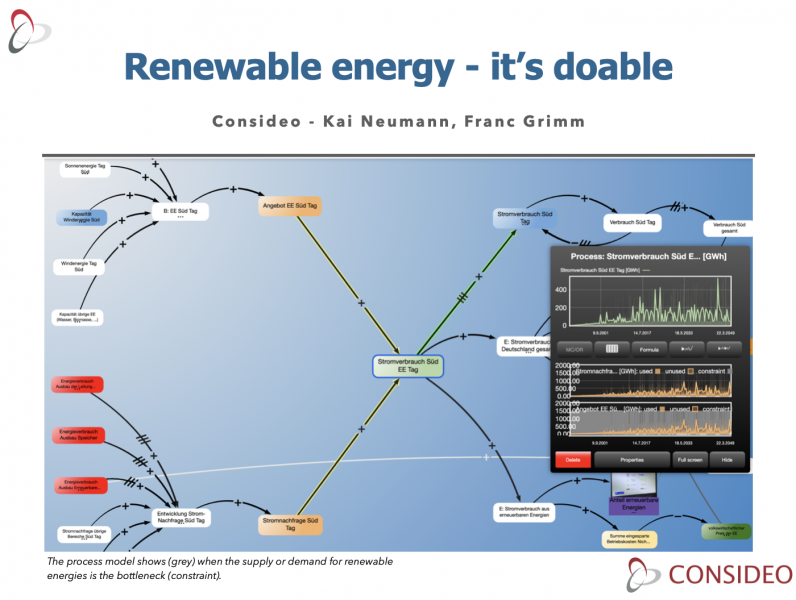 Luebeck, den 30.10.2020
Luebeck, den 30.10.2020
Grey series - Part 1: Renewable energy - it is doable
Authors: Kai Neumann and Franc Grimm
Abstract: In two simulation models for the German Federal Environmental Agency, Consideo has systemically investigated first the implications of a national and then the implications of a global transformation to renewable energies systemically.
The D3 EE model shows for Germany what net expansion would be needed to achieve the self-imposed goals of greenhouse gas neutrality by 2050 including electrification of mobility, building energy and industry. The model shows that the current expansion will hardly enable the targets to be met, even with a later increase in expansion, as the repowering of old plants will tie up capacity. It also shows the excess capacity needed to survive the dark periods via power to gas/liquid and its reconversion to electricity. It is interesting to note that while the price of electricity could still increase slightly, the economic benefits through increased domestic value creation would be enormous.
The GEE(R) model points to the extent to which global expansion depends on the availability of key resources. Although raw material reserves will be sufficient, the required extraction and recycling capacities would be extreme depending on the expansion pathways in the regions of the world. These pathways are thus also relevant to the prices of expansion.
Many regions in the world will benefit from increased value creation, but some will also become losers from the change.
The "gray series": With the "gray series" we offer the public an attractive format to read, which brings findings from our research projects and actions to be derived from them to the point - our 'gray series' in reference to the term "gray literature".
"Renewable Energies - It Could Be Done" does not merely show, like other studies, that 100 percent renewable energies would be possible in principle and presumably also economically viable, but takes a concrete look at the course and dynamics. This results in particular in economic implications related to the timing and extent and, in addition, the costs and benefits of the expansion in the regions of the world.
You can download the publication directly here.
Economics Journal Article No. 2018-25, April 30, 2018
 Economics: The Open-Access, Open-Assessment E-Journal, 12 (2018-25): 1–19
Economics: The Open-Access, Open-Assessment E-Journal, 12 (2018-25): 1–19
Participatory, explorative, qualitative modeling: application of the iMODELER software to assess trade-offs among the SDGs
Authors: Kai Neumann, Carl Anderson, and Manfred Denich
Published in (Special Issue The Sustainable Development Goals—Assessing interlinkages, trade-offs and synergies for policy design)
Abstract: The UN’s Sustainable Development Goals (SDGs) in their generalized form need to be further reflected in order to identify synergies and trade-offs between their targets, and to apply them to concrete nations and regions. Explorative qualitative cause and effect modeling could serve as an approach for considering crucial factors to better understand the interrelations among the SDGs, eventually leading to more informed concrete measures that are able to cope with the SDG’s inherent obstacles. This work describes a model that could serve as a template for concrete application. The generalized model already points to some potential trade-offs. Its first analysis cautiously raises doubts that some possible assumptions behind the SDGs might overlook systemic boundaries. For example, an undifferentiated increase of productivity contradicts a lessened environmental impact and need for resources in light of potential planetary boundaries. However, the model was developed as a starting point and requires modification for its application to a concrete region.
View / Downlaod article: http://dx.doi.org/10.5018/economics-ejournal.ja.2018-25
A Business Culture of Reflection - Part 1: Systemic Strategy Development and Risk Analysis (including Strategy Maps and SWOT Analysis)
Author: Kai Neumann
Abstract: This paper describes the modeling process of a qualitative model (with a quantitative model briefly referenced in the appendix) of the strategy development and risk analysis of a startup enterprise that intends to develop an electric vehicle (E-car). It is only a rough model intended to show the general methodology of qualitative modeling of strategies using the iMODELER (by Consideo: www.consideo.com). By reflecting on an enterprise and its environment to develop a strategy we form the basis for deriving a Dynamic Strategy Map (Kaplan/Norton: Strategy Maps), a systemic SWOT Analysis and a Systemic Risk Analysis - all of which rely on this reflection.
This guidance comes in a series of guidances for “A Business Culture of Reflection” in line with:
1. Systemic Strategy Development including Risk and SWOT analysis
2. Systemic Product Development featuring Idealized System Design
3. Quantitative Optimization and Risk Analysis of Projects and Processes
4. Systemic Project Management
5. Systemic Management and Organizational Development featuring KNOW-WHY Method
The series describes the application of the software iMODELER (both, the freeware and the full version) for the example of a start-up enterprise (newly founded or a profit center within a company) that plans to become successful with developing, manufacturing and selling a revolutionary electric car.
The culture of reflections captures the idea that any enterprise could leverage the collective potential of its employees once it would collaboratively look at the interconnections of all the existing arguments within the enterprise (and from the stakeholders outside). Not just phenomena of endless and repeated meetings with little progress but also reluctant decision making or simply the problem of wrong decisions would be tackled with this change of corporate culture.
Here you can download the guidance: A Business Culture of Reflection – Part 1
Here you will find the model: https://www.know-why.net/model/C2Hbs8XnHom31Np2sjcr8cQ
A Business Culture of Reflection - Part 3 (Quantitative Optimization and Risk Analysis of Projects and Processes)
Author: Kai Neumann
Abstract: This guidance describes a quantitative model about the start-up of an enterprise that develops an electric vehicle (E-car) to then manufacture and sell this car. It is only a rough model that shows the general methodology of quantitative modeling using iMODELER’s process and project factors and its features to consider likelihoods of developments (e.g. for risk management) and optimization of parameters (e.g. for Operations Research with iM Optimizer). Well, actually it allows for a lot more applications, e.g. financial planning, Theory of Constraints, corporate forecast etc..
This guidance comes in a series of guidances for “A Business Culture of Reflection” in line with:
1. Systemic Strategy Development including Risk and SWOT analysis
2. Systemic Product Development featuring Idealized System Design
3. Quantitative Optimization and Risk Analysis of Projects and Processes
4. Systemic Project Management
5. Systemic Management and Organizational Development featuring KNOW-WHY Method
The series describes the application of the software iMODELER (both, the freeware and the full version) for the example of a start-up enterprise (newly founded or a profit center within a company) that plans to become successful with developing, manufacturing and selling a revolutionary electric car.
The culture of reflections captures the idea that any enterprise could leverage the collective potential of its employees once it would collaboratively look at the interconnections of all the existing arguments within the enterprise (and from the stakeholders outside). Not just phenomena of endless and repeated meetings with little progress but also reluctant decision making or simply the problem of wrong decisions would be tackled with this change of corporate culture.
Here you can download the guidance: A Business Culture of Reflection – Part 3
Here you will find the model and its variants: https://www.know-why.net/model/COfweXMDN6IXVjBu_L73gRw
The version using iM Optimizer: http://www.imodeler.info/ro?key=Cv-vW-0iM4jA9XyEX5IUQcw
The version using Monte Carlo simulations: http://www.imodeler.info/ro?key=C3e5iEZDsZINOLEwDCa786w
Development of an Integrated Assessment Model: Sustainable Development in Germany
Authors: Kai Neumann, Franc Grimm, Prof. Harald Heinrichs
Published by Umweltbundesamt (Federal Environment Agency of Germany)
Abstract: Sustainability has a social, economical and ecological dimension. These dimensions are highly interconnected and interdependent. Despite tremendous knowledge about the different fields and the severe pressure from social, increasingly economic and above all ecological developments there is little, if any progress on our way to a sustainable society. To get a deeper understanding of the underlying reasons this work is based on a systemic, explorative, qualitative cause and effect model build together with a series of experts and stakeholders from different fields. From its analysis stem a number of crucial insights: Any player could address Biopsychological motives of human behavior in order to foster feedback loops that could form a transformation towards more sustainability. Currently, these feedback loops describe a lock-in situation that prevents any change. An additional measure could be an intelligent scoring system to address the human motives. Also effective would be to make the basic background knowledge common as a basis for a public vision to manifest the change. Until change has developed its momentum any player should provide basic background knowledge, a vision, a way to score the alternative that is provided and hence make change emotionally effective.
Please ask for further information (info@consideo.de)
![]() Here you will find the publication in german: UBA-Text 74/2014
Here you will find the publication in german: UBA-Text 74/2014
Swedish Environmental Protection Agency - Report 6602, February 2014
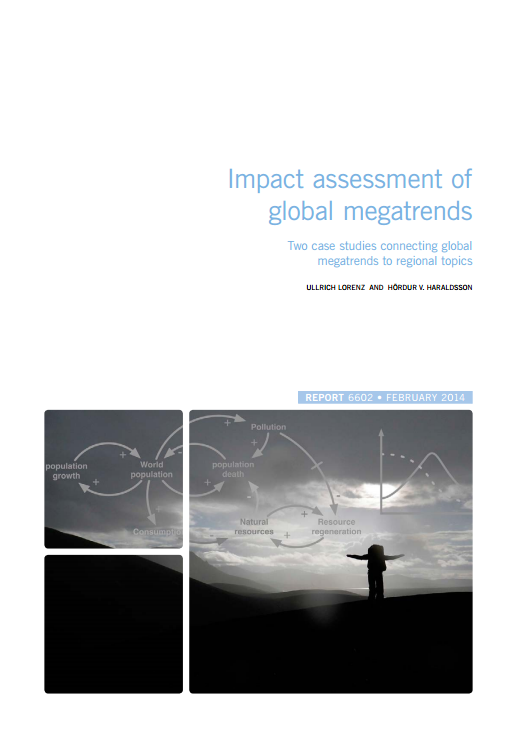
Impact assessment of global megatrends - two case studies connecting global megatrends to regional topics
Authors: Ullrich Lorenz and Hördur Haraldsson
Published by SWEDISH ENVIRONMENTAL PROTECTION AGENCY
Abstract: This report gives an overview how global megatrends can influence topics on regional and local level. The report demonstrates how qualitative modelling and system thinking approach can be applied to analyse the possible impact of global megatrends to the regional topic of resource scarcity, demonstrated in two case studies. In the first case study, a generic qualitative model is developed to explain a general pattern of resource scarcity on a EU regional scale. Typical entry points of political measures are shown as well as how the eleven global megatrends – described by the European Environment Agency – can be connected to such a model. Potentially, some of the global megatrends will increase the problem of resource scarcity while others will put relieve on the challenge. A third group of megatrends has apparently now impact on the resource scarcity pattern. In the same way, the possible impact of the policy measure can be compared. In the second case study, a qualitative model is built to explain the impact of the global megatrends upon the Swedish environmental goals. The case study illustrates how the different scales: local, EU regional and the global scale connect through the megatrends, and how they impact the possibility of fulfilling the Swedish environmental goals. In conclusion, we are able to demonstrate that the global megatrends put in nearly all cases more burden to environmental challenges respectively the environmental goals. The potential impact of global megatrends differs in time and spatial scale. Generally, the methodology of qualitative modelling has proven to be a powerful approach to assess the potential impact of global megatrends to regional or concrete topics as well as to assess the potential impact of policy measures in terms of goal reaching.
![]() Here you will find the publication in english: SWEDISH ENVIRONMENTAL PROTECTION AGENCY REPORT 6602
Here you will find the publication in english: SWEDISH ENVIRONMENTAL PROTECTION AGENCY REPORT 6602
Journal Article E:CO Issue Vol. 16 No. 2 2014
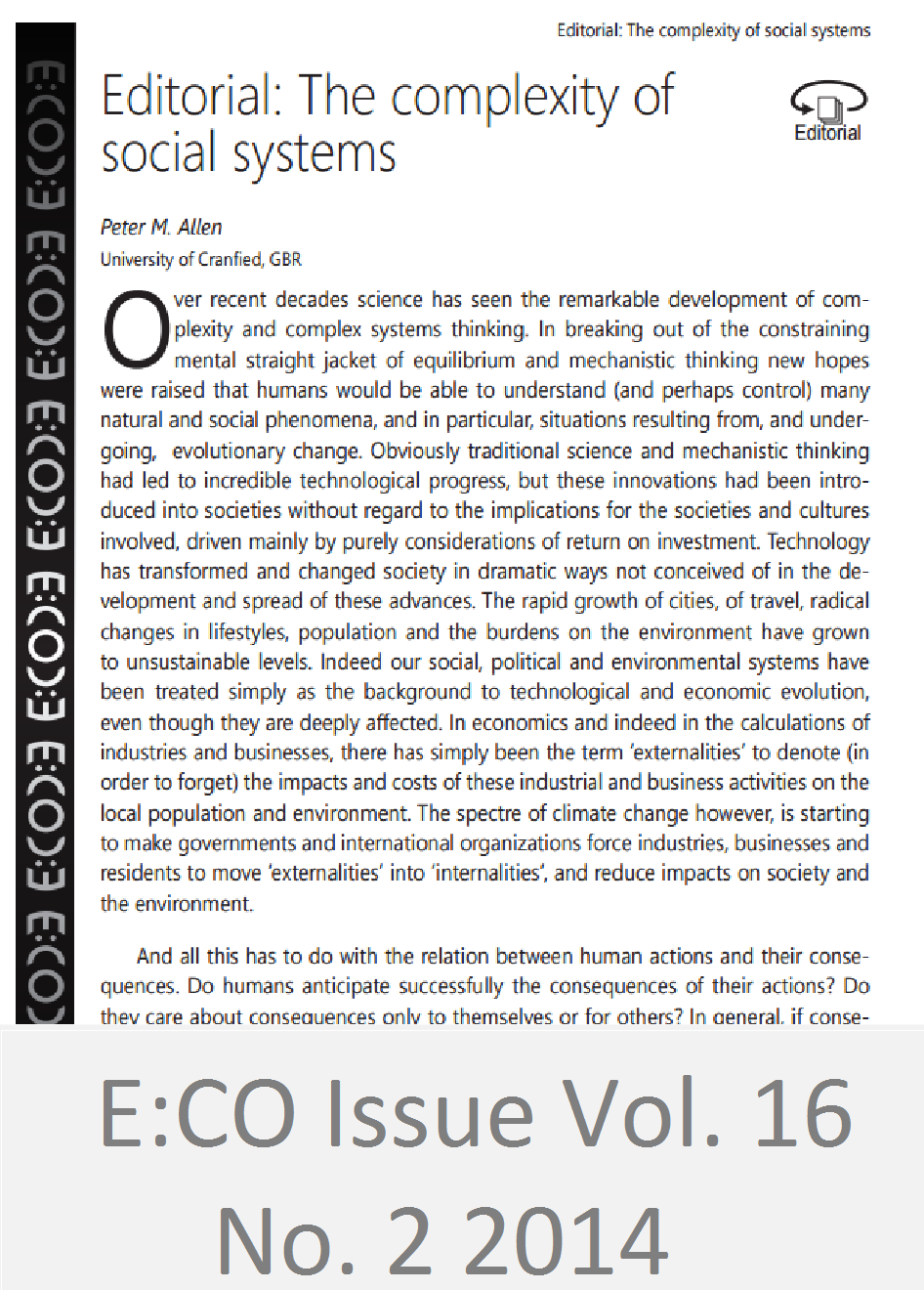 Reflecting on Comlex Challenges through Qualitative Modeling using the iMODELER (29-43) / Kai Neumann
Reflecting on Comlex Challenges through Qualitative Modeling using the iMODELER (29-43) / Kai Neumann
Abstract: As our challenges become more and more complex and we as a result face mental boundaries, we need tools that help us to grasp the dynamic interconnections of a large number of factors. While quantitative modeling approaches can only be used by modeling experts, qualitative modeling—which is much easier to apply—is not very well known. Consideo has come up with an advanced yet surprisingly easy qualitative modeling approach and method with its software iMODELER. Here, different kinds of (rough) weighting of interconnections between factors are done first, followed by the analysis of the model through so-called insight matrices, making it possible to identify the short, medium and long-term importance of the factors involved and thus, for example, compare measures, risks and goals. The model will not be useful, however, unless it features factors that are crucial. A methodology devised to help you determine what the crucial factors are is the easy-to-apply KNOW WHY Method. Next to this I will discuss the important difference between explorative and descriptive modeling and name some practical and psychological obstacles that keep us from making the effort to model. It is my conviction that by modeling we would make it possible for a new culture of increased transparency—through better planning, decision-making and communication—to emerge.
![]() Here you will find the article: E:CO Issue Vol. 16 No. 2 2014
Here you will find the article: E:CO Issue Vol. 16 No. 2 2014
Journal Article E:CO Issue Vol. 15 No. 3 2013
KNOW-WHY Thinking as a New Approach to Systems Thinking (81-93) / Kai Neumann
Abstract: This paper is on the background of so-called KNOW WHY Thinking—a systemic approach that can be used to reflect on all kinds of complex situations. The approach is based on evolutionary logic, according to which everything in the world, whether it is a product, an organization, a project or an individual needs to both adapt and develop in order to be successful. It needs to adapt to its environment and surrounding circumstances: this is referred to as its need for integration. It also needs to develop with the changing environment and in many cases also beat out the competition: this is referred to its need for development. While many systems theories describe how certain systems work, this approach describes why they work and also why other systems do not. This paper provides a range of examples illustrating this. One very useful way of applying this mode of reflection is using it to explain the motivation of human behavior. Humans either act based on rationality and discipline, or they are motivated by feelings. All our feelings can be categorized into two groups: they either help us to integrate into our environment or to develop so that we can adapt to changes or compete with others. No human emotion exists that cannot be categorized into one of these two groups: we follow evolutionary logic. Reflecting on human behavior in this way allows us to understand other—in many cases contradictory—approaches that explain human motivation. Both the KNOW WHY of success (of systems) and the KNOW WHY of human behavior can be used to reflect on our daily challenges. Together with a cause and effect modeling tool, all of the ideas and principles behind KNOW WHY can be applied as the so-called KNOW WHY Method. This method helps you to include the crucial factors within a model. Not only is this approach very powerful—it is easy to use, and therefore has the potential of being applied by many more people than other, rather complicated and abstract systems approaches are.
![]() Here you will find the article: E:CO Issue Vol. 15 No. 3 2013
Here you will find the article: E:CO Issue Vol. 15 No. 3 2013
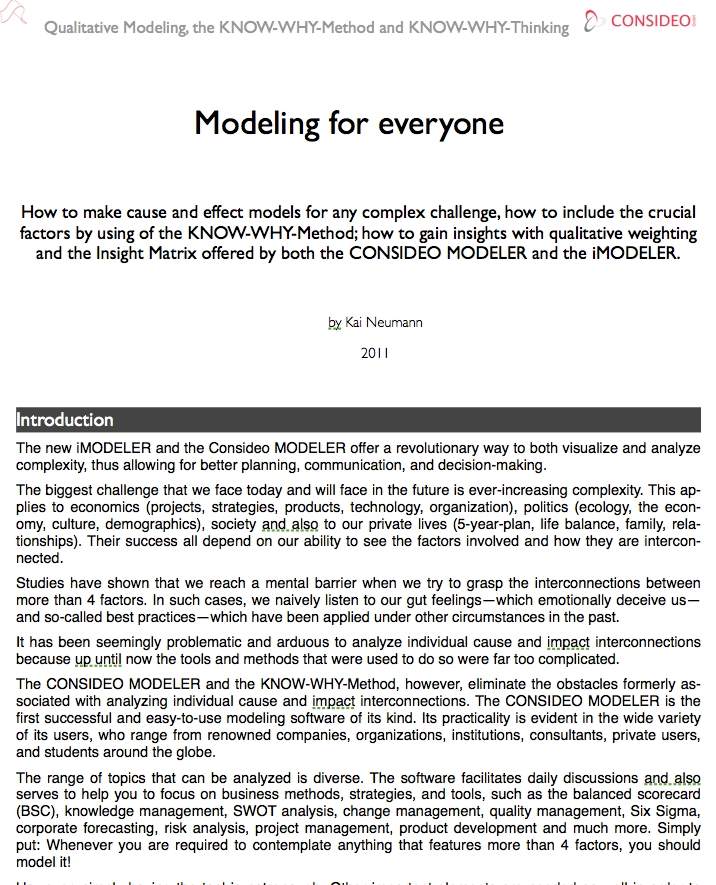 Lübeck, 15.05.2013
Lübeck, 15.05.2013
Tipps and Tricks and Background of Explorative Qualitative Modeling
Here you will find some useful tipps and some background information on modeling, the insight matrix and the KNOW WHY method.
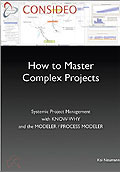 Lübeck, 03/09/2010
Lübeck, 03/09/2010
How to master complex projects
Your projects will fail if you do not consider the crucial factors or if you misinterpret their interrelationships. Actually there is no other reason for a project to fail. This gratis e-book explains with a concrete example how we can cope with the complexity of a project, how we can think of the crucial factors using the KNOW-WHY-method, and how we can run scenarios on the different possible courses a project might take using the CONSIDEO PROCESS MODELER and the Monte-Carlo-simulation. It shows how we can grasp the impacts of change of specification, the dynamics of motivation, the possible chain of reactions due to the outage of resources, etc.. This book on systemic project management even includes the theory of constraints (ToC) from Goldratt. The book not only emphasizes the new way of thinking and the use of a tool but also the management of a project team, the perception of people and the communication.
